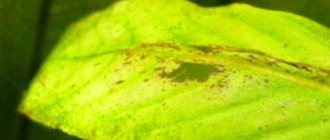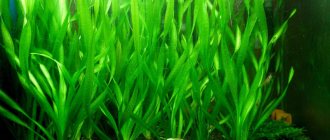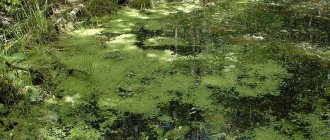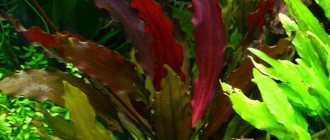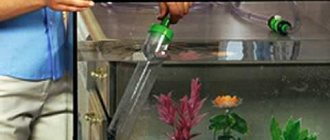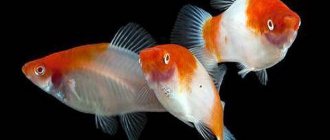Plants
The aquarium world consists not only of fish, but also of vegetation that needs regular care. One of the stages of caring for aquatic flora is the creation of a nutrient medium using fertilizing. You can purchase fertilizers for aquarium plants in a specialized store.
But inexperienced aquarists are often confused when they see the large assortment of nutritional mixtures offered. Therefore, you must first become familiar with the features of fertilizing for aquatic vegetation. And having gained some experience, it will be possible to prepare the drug at home.
Why do we need fertilizers?
Before you understand what is best to use for fish, you need to understand the goals of using various fertilizers.
So, the main goal is guaranteed and complete nutrition of plants. At the same time, plants can grow due to the fact that fish live in the aquarium and secrete waste products. In some situations, what the fish provide will actually be enough, but the situation may not always turn out that way.
Even if the food comes with new water, which is taken from the tap, this may not be enough when changing the liquid in the aquarium.
Ermolaev’s fertilizers are aimed at activating the growth rate of plants. Moreover, it is assumed that it is possible to improve the external condition of green plants. An aquarium in which plants can grow quickly becomes beautiful. Such results can only evoke positive responses from experienced aquarists. Despite the fact that it is impossible to constantly add beautiful fish to the aquarium and it is a pity to part with them on an ordinary whim, a solution to the existing problem can be found. Plants provide more options for creating an aquarium world.
In some cases, aquarium fertilizers cease to be a whim and turn out to be truly important. Fertilizing plants is mandatory if carbon dioxide is used. If gas supply is not expected, you can focus on the condition of the plantings. A small amount of green space suggests a sufficient amount of nutrition from changing water and fish, but subsequently the situation changes dramatically.
After the plants grow to a certain mass, they already experience a lack of nutrition and begin to grow slowly. Hardy plants can still grow quickly, but only at the expense of other plantings that have a more finicky nature. This situation indicates that in any case it is necessary to use special products from Ermolaev or other manufacturers and developers.
Plant fertilizers from Tetra
TetraPlantCrypto.
Tablets for feeding the roots of succulent, healthy aquatic plants that absorb nutrients through the roots. Fertilizer for intensive root formation and nutritious aquarium substrate. The preparation contains iron and all important microelements in an easily digestible form, adapted to the specific requirements of the soil, thus supporting the soil microflora.
It has a high iron content, quickly eliminates its deficiency in the aquarium, and is very effective against both cryptocorynes and other “iron-dependent” hydrophytes, in particular Vallisneria, Barclay. Nutrients are available to plants for a long time. Does not contain nitrates and phosphates, does not cause water pollution and inhibits the development of algae. Promotes the vital activity of soil microorganisms. Dosage: 1 tablet per 20 liters of water. It is introduced into the soil, in close proximity to the root system of plants. The tablet form allows you to place it exactly under those plants that need it. Tetra Plant Flora Pride Red
Liquid fertilizer for red aquarium plants. Contains iron, necessary for abundant plant growth. Special components such as potassium and manganese strengthen plants and promote fast and healthy growth. The drug is evenly distributed in the water and penetrates the plants through the leaves. Strengthens plants with nutrients over a long period of time. Promotes the formation of chlorophyll, which is responsible for the rich color of plants. Prevents algae growth. Does not contain nitrates, phosphates and does not cause water pollution. With each water change, 10 ml per 20 liters of water. Shake well before use. Tetra Plant Initial Sticks.
Sticks. A complex iron-containing fertilizer that compensates for nutrient deficiency in the soil of a new aquarium and replacement aquarium soil. The basis of this preparation is granulated humus, which is a natural source of assimilates necessary for the full functioning of aquatic flora. They create a long-term nutrient medium for plant roots. Aquatic plants quickly take root and suppress the growth of algae, which is especially important when setting up a new aquarium.
It is a long-lasting fertilizer, ensures enhanced growth of aquarium plants and does not contain components harmful to fish. Does not contain nitrates and phosphates, therefore does not pollute water. Environmentally friendly and designed for use in freshwater aquariums. The drug helps create a beneficial microenvironment in the soil.
Application: mix fertilizer sticks with the soil (at the rate of 1 g of fertilizer for each liter of aquarium water; when setting up a new aquarium, stick the sticks into the soil of an existing aquarium; if additional plant nutrition is required. Tetra Plant Planta Min. Liquid fertilizer with iodine and vitamin B, for aquatic plants. This is an intensive fertilizer that is used for the development of beautiful dark green aquatic plants. Nutrients are absorbed through the leaves. Contains iron, manganese, potassium and a complex of all nutrients necessary for leaf growth. Promotes the formation of chlorophyll, guarantees an even, long-term supply residual elements. The fertilizer promotes the development of healthy and strong plant roots. Free from nitrates and phosphorus, which means there is no burden on the existing natural environment in the aquarium. Unwanted algae growth is prevented. Dosage: 5 ml per 10 liters of aquarium water. After 4 weeks, apply in half the amount indicated. Tetra Plant Planta Start. A tableted complex fertilizer containing all the main macro- and microelements necessary for the normal development of aquatic plants. Fertilizer for aquarium plants provides newly planted plants with a complex of essential nutrients. Fertilizes plants through the roots. This is a kind of growth catalyst that protects and strengthens the root system of plants, helping it recover as soon as possible. In addition to a wide range of micro- and macroelements, it contains a root formation stimulator, which promotes rapid adaptation and expansion of the root system in newly planted plants.
Improves the survival rate of transplanted plants. The plant hormone included in the composition enhances growth. Promotes root formation. Improves root survival during planting and replanting. Strengthens resistance with macronutrients. Dosage: 1 tablet per 50 liters of aquarium water. Placed in the ground in close proximity to the root area. ZMF Dynoplant. Pills. Fertilizer for providing plants with nutrients through the root system.
Types of biocenoses for proper fertilization
The type of biocenosis affects the sequence of fertilizer application. There are no living creatures in Dutch phytoaquariums. Restoration of the nitrogen cycle occurs slowly due to dead plant particles. For older aquariums, root sticks and microadditives are used, while for young aquariums, only microelements are used. Dutch herbalists are difficult to care for. There are no consumers in them, and the natural biological cycle is disrupted. Because of this, the volume of Dutch containers is 300-400 liters.
Aquariums with different types of biocenosis.
Angelfish are released into large home phytoaquariums, and unpretentious fish, including rasbor and puntius, are placed in small ones. Only potassium is added to water supplemented with macroelements. Microadditives are used according to the scheme.
When the aquarium is populated with a large number of fish, feeding the plants is not necessary, and in low light it is not used at all.
In addition to population density, the ratio of animal to plant mass is taken into account. Highly lit tanks are fertilized with iron every day, but stop when a few fish are preparing to spawn.
Which fertilizers to choose: aquarium or branded?
Homemade aquarium fertilizers are now offered, as well as branded products. Which option is the most preferable? Why can you prepare fertilizers yourself?
Homemade fertilizers are ready to please you with the best price. Moreover, their cost is radically different from the cost of branded products. Moreover, even Ermolaev’s products are immediately offered at an increased cost and cease to be as profitable as we would like.
The most important thing is to understand how to prepare homemade feed mixtures in order for them to provide maximum benefit. You need to prepare in advance to buy a large amount of chemicals, and it is far from a fact that they will be successfully used during the entire time you are interested in aquarium keeping. For this reason, initially homemade fertilizers will require much more financial investment than branded products, but subsequently stabilization will occur.
In most cases, this approach is a priority for aquarists who initially have optimal basic knowledge of school chemistry and strive for numerous experiments and want to monitor the condition of aquarium plants.
Branded fertilizers are the best choice for people who initially strive for beautiful and healthy green spaces. In addition, such aquarists can confirm that preparing fertilizers yourself is an unnecessary headache and a common waste of time. You need to understand that homemade fertilizers always maintain a certain level of quality, but at the same time, branded products can be improved on an ongoing basis. Manufacturers who are trying to mass produce products are interested in improving the quality of the products they offer. Ermolaev’s products also include a variety of fertilizer options and are getting better every year.
Public recipes for homemade products are unchanged. Only those aquarists who initially have decent knowledge can understand how best to improve the composition. The formulas of branded products initially involve the use of special additives, which guarantees the possibility of improving their storage. At the same time, it is easier to prepare homemade products again than to worry about improving resistance to fungus and mold after successful storage in the refrigerator and even freezer.
FAQ. Popular questions
How can you add fertilizer to aquarium plants?
Fertilizers intended for aquarium plants can be added to the water or soil.
What are the benefits of fertilizing?
Fertilizers contain the most important elements for plants in optimal proportions - these include phosphates, nitrates, potassium, iron, nitrogen, manganese, etc. Using them is quite simple - you need to add the mixture to the soil, after which the plant roots will begin to absorb nutrients, and the result is usually noticeable within a few weeks.
What is better - branded or homemade fertilizers?
The question of choosing between branded and homemade fertilizers is quite complex, but the developer of aquarium preparations, Sergei Ermolaev, advises beginning aquarists to use ready-made products. Homemade fertilizers can be used by those who are well versed in chemistry and like to experiment.
When and how to add root fertilizers?
The method of using root fertilizers is the same - they need to be buried in the soil near the roots of the plants in the dosage indicated on the package. The recommended application time is also indicated in the instructions, but experienced specialists often rely on the appearance of the plants. With a lack of fertilizers, they grow slowly, become deformed, turn yellow, and do not look so lush and bright. It is best to carry out the procedure in the morning, since plants require more nutrition during daylight hours.
Tetra General Tonic Tetra Contralck Sidex Tetra Bactozyme Tetra Vital Tetra NitrateMinus Tetra AquaSafe Hydrogen Peroxide
Features of liquid fertilizers for aquariums
Recently, liquid fertilizers have become increasingly in demand. Questions regarding their use are specific. Moreover, in most cases, aquarium owners ask: “is it possible to use macro- and microfertilizers at the same time?” The nature of this issue is completely clear.
Phosphate from a mixture of macroelements can be the basis for the creation of insoluble compounds, which include cations of a mixture of microelements. However, this opportunity appears only if you mix liquid macro- and microfertilizers. If you initially add the products to the aquarium, you can understand that the components will be greatly diluted. Subsequently, the creation of insoluble compounds ceases to be possible. For this reason, to change the components of fertilizers, care must be taken to simultaneously use macro- and micro-components.
It is believed that macroelements are best consumed by green spaces at night, so it is recommended to apply such components in the evening so that they can show maximum benefit. This statement can be found on numerous forums for lovers of aquarium fish and plants. However, the recommendation is questionable: the absorption of nutritional components occurs only with the receipt of light, therefore liquid micro- and macro-fertilizers are best applied early in the morning.
Previously, fertilizer manufacturers recommended adding nutrient mixtures once a week. Most likely, such advice was based on a certain laziness of aquarists, because manufacturers did not want to scare off the target audience. Despite this, the products of Ermolaev and other developers should be introduced regularly and evenly. Daily use of fertilizers can provide decent results, which can never and under no circumstances be achieved when the procedure is carried out once a week.
How to choose MICRO for an aquarium
We already have dozens of aquarium chemical manufacturers. How to choose? We use Blue Barbus products. You choose what you want. After all, not only MICRO can be used there. And there are different proportions in the elements. And yet, potassium and iron can be completely different from different manufacturers with different levels of digestibility. And some develop separate ones for soft water and for hard water separately. The only thing in the table is that you must understand whether you are buying water or the actual active substance. Table made on January 1, 2021. The table did not include fashion brands such as Ehaim, Tetra, Tropical and Dayana. Ukrainian companies, for example Rikka, Amazon, also suffer from this. They don’t have a lineup, and writing everything super-duper is not an argument for me. I need to know what I'm pouring, not just pouring something that they say is cool.
| Mg | Cu | Fe | Solution density | Price | Efficiency | |
| Blue Barbus | 12,2 | 0,6 | 30,6 | 54,8 | 150 | 36,53333 |
| ECOMIN | 1,8 | 0,052 | 1,3 | 4,14 | 60 | 6,9 |
| Aquayer | 0,8 | 0,045 | 1,2 | 2,9 | 79 | 3,670886 |
| AquaSys | 0 | 0,015 | 1 | 1,3 | 63,66 | 2,042099 |
| JBL | 0,5 | 0,003 | 0,1 | 0,66 | 220 | 0,3 |
| PAN | 0 | 0,024 | 2 | 2,48 | 75,68 | 3,276956 |
| Ptero | 0,043 | 0,001 | 0,043 | 0,106 | 94 | 0,112766 |
| Florastim | 12,2 | 0,6 | 30,6 | 54,8 | 195 | 28,10256 |
| Dennerle | 2 | 0,05 | 2,5 | 5,5 | 169 | 3,254438 |
The density of the solution is a hypothetical value. Equal to Mg+Fe+Cu*20. Approximately shows how full the solution is. The higher, the greater the concentrate.
Efficiency = density/price. The higher the better.
Complete water is JBL, Ptero.
Which brand of aquarium chemicals to choose
The most effective brands are Blue Barbus, Florastim. Everyone else is ahead by a wide margin. Please note that the Florastim brand was considered a concentrate (there is a model 4 times diluted). The much-praised Aquayer is 10 times more expensive in price. Although you can’t tell by looking at the bottle – it’s the same size.
Blue Barbus micro complex for aquariums. 250 ml. Maximum concentrate.
Therefore, when I apply 2 sprays of MICRO per 225 liters for plants in the office, sometimes my windows begin to become covered with algae. This is a concentrate, not water.
Effective mode of fertilizer use
Different manufacturers specify different fertilizer dosages. What is the reason for this? What doses best exhibit beneficial properties?
The reasons for the difference are explained by technologies for growing and maintaining plants. There are truly many systems, and opinions differ even more. Systems can be designed for different purposes, so it is vital to ensure that they are suitable for effective use. In order to understand why the dosages of Ermolaev and all other manufacturers are radically different, you need to understand the features of the approaches to performing the assigned tasks.
By studying all existing systems for growing aquarium plants, you can give preference to the most suitable technologies. Commercial systems involve the use of specific brands of products, and manufacturers may develop fertilizers for specific applications. The most important thing is to understand what fertilizers are required for aquarium plants and what tasks must be successfully completed. Any worthy developers, including Ermolaev’s company, try to focus on a specific niche, since only in this case can one count on decent results from the planned activities.
It is important to remember that micro- and macroelements interact with each other, so they can manifest their properties differently.
Cost of fertilizers from different manufacturers
| Manufacturing company | price, rub. |
| Tetra Plant Initial Sticks | 425 |
| Tetra Plant Crypto | 385 |
| Tetra Plant Plantstart | 570 |
| Sera Flora Plus | 200 |
| Sera Florenette A | 362 |
| JBL Ferrotabs | 480 |
| JBL Die 7+13 | 490 |
| AQUAYER UDO Ermolaeva tablets | 270 |
| Dennerle Power Tabs | 480 |
| Dennerle Deponit NutriBalls | 580 |
| API Root Tabs Plant | 780 |
| Tropica Nutrition Capsules | 490 |
What components do aquarium plants require?
Before you understand what kind of feeding is required from Ermolaev or another developer, you need to carefully study the basic properties of the manufactured components:
- Nitrogen (N) can appear through the breakdown of ammonia, nitrates, and also nitrites. These compounds turn out to be truly important for green spaces. The lack of nitrogen can be compensated for by fertilizers, which are developed in various consistencies with maximum ease of use. The optimal level of nitrate feeding should be from ten to twenty ppm.
- Phosphorus is a macronutrient. Aquarium fertilizers from Ermolaev, which contain phosphorus, are required for active growth and maintaining good plant health. The best option is a low level of phosphorus in the aquarium water. In addition, it is advisable to reduce the amount of the incoming component, because the chemical element is initially a component of fish food. Phosphorus deficiency visually resembles the consequences of nitrogen deficiency: yellowed and dull aquarium plants.
- Potassium is the third and final micronutrient required by plants growing in aquariums. The component is primarily required for aquariums with low to medium lighting. The optimal level is from ten to twenty ppm. However, if necessary, the dose of incoming components can be increased.
Studying the microelements that modern fertilizers for aquarium plants should include. It is impossible to count on favorable results from growing plantings without microelements.
Benefits of root feeding
Not all hobbyists use fertilizing, but experienced aquascapers (people who create living compositions in aquariums) recommend not to ignore them.
Plants can receive the substances necessary for development from fish waste products, but when fertilizing is applied, their growth and appearance are significantly improved.
The aquarium becomes more attractive and constantly changing, so it is very interesting to watch. If the volume of the tank is large enough and there are a lot of plants in it, fertilizers are simply necessary, otherwise the growth of flora representatives will slow down, they will become weak and inexpressive.
Fertilizers intended for aquarium plants can be added to the water or soil.
The second option is called root feeding, and is considered more preferable, since representatives of the flora better absorb nutrients from the soil. This is especially true for bushes and specimens with a developed root system. Fertilizers are used for the following purposes:
- creating a normal biological atmosphere in the aquarium;
- improving the survival rate of plants during planting and replanting;
- activation of root growth and saturation with macro- and microelements;
- protection of plants from diseases.
Fertilizers contain the most important elements for plants in optimal proportions - these include phosphates, nitrates, potassium, iron, nitrogen, manganese, etc.
Using them is quite simple - you need to add the mixture to the soil, after which the plant roots will begin to absorb nutrients, and the result is usually noticeable within a few weeks.
An excess of fertilizers is no less harmful to plants than a lack of them, so fertilizing should be added in accordance with the recommendations of manufacturers and experienced aquascapers.
What food is recommended for an aquarium?
When choosing a feed mixture in the future, you should be guided by general recommendations:
- Liquid mixtures. If a general product is selected, it is ideal for aquariums that initially suffer from a lack of light output.
- Liquid mixtures that are created based on individual recipes and include a variety of nutritional elements. Such complexes are ideal for medium-light aquariums and young plants. In order to expect favorable results, it is advisable to follow the dosage, and the recommendations of Ermolaev and other manufacturers will always vary.
- Dry powder can also be used to provide nutrition for plants. These products are ideal for highly lit aquariums. By choosing dry powder, you can guarantee more economical use compared to liquid products. The most important thing is to follow the feeding instructions.
Release forms
Manufacturers produce preparations for feeding aquarium plants in different forms - liquid or solid.
Liquid mixtures are suitable for algae that do not have a root system. Absorption of valuable substances occurs through the leaves. The advantages of liquid mixtures include ease of use. But if there is a filtration system, some of the beneficial substances are retained inside the filters, which requires regular use of fertilizing.
Solid substances are available in granules, tablets, pellets and as a nutrient substrate. The advantages of this type: rapid absorption by plants and long-lasting effects due to the gradual absorption of nutrients. Placed in the ground or under the roots of weakened plants.
The liquid form is more convenient to use. But the effect of solid nutritional mixtures is prolonged . This means that the dissolution of the composition occurs slowly. Thanks to this, the root system is provided with nutrition for a long time. Therefore, re-application is carried out after complete dissolution of the old fertilizer.
How to use fertilizers correctly?
In order for aquarium fertilizers to show maximum benefit, you need to count on following certain recommendations:
- Before starting the aquarium, only potassium can be used. Otherwise, it will be difficult for plants to develop.
- The aquarium environment must be stable, otherwise fertilizers will be useless.
- Initially, you need to use minimal doses. The best option is a third of the norm. It is important to carefully monitor the condition of the flora.
- If you do not follow the instructions and dosages, algae can develop extremely quickly.
- The effect will appear 3 – 4 weeks after the start of using fertilizers.
- It is advisable to add microelements in the morning, and macroelements in the evening.
- One-component fertilizers can only be mixed if their composition is compatible. Otherwise, an unpleasant sediment will appear in the aquarium.
Compliance with the above recommendations allows you to count on the successful growth of healthy and beautiful aquarium plants.
DIY fertilizer for aquarium plants
Tips for aquarists
Beginners are often interested in whether it is necessary to feed plants from the first days of the aquarium’s existence. Experienced aquarists consider this unnecessary when using nutrient soil. Only feeding with potassium is allowed. But if ordinary soil was used to start the aquarium, then the plants will experience a deficiency of nutrients and in this case replenishment is necessary.
Most aquarists apply fertilizer by hand. Experts recommend using an automatic method using a dispenser. This device is especially convenient for those who are often on the road. The device independently supplies the required amount of nutritional supplements at the right time. You can make a dispenser yourself, but it is better to purchase a ready-made mechanism, especially since these devices are inexpensive.
Which fertilizer to purchase - ready-made or homemade - everyone decides independently, based on their own preferences, the amount of vegetation in the aquarium and the species of aquatic crops. Whatever method is chosen, the main thing is that the plants grow healthy and delight the eye with their beauty.
Phosphates
The breakdown of organic matter releases nitrogenous compounds that the plant uses as nutrition. Another key element for energy production in plant cells is phosphate.
Phosphates enter the water as a result of the metabolism of aquarium inhabitants. So, when there is little phosphate in the aquarium, plant growth slows down.
Phosphates and nitrates are constantly released in the aquarium due to the breakdown of food residues and fish contamination and are therefore always available in sufficient quantities. Due to this, aquariums inhabited by fish, as a rule, do not require fertilization with these nutrients.
If there is an excess of phosphates and nitrates that the plants are unable to consume, these nutrients stimulate the growth of algae, which begins to quickly spread in the aquarium.
"AQUAYER": a line of proprietary fertilizers
Particular attention should be paid to the so-called proprietary fertilizers. For example, founded by candidate of chemical sciences Sergei Ermolaev, it produces a line of very high-quality drugs for various purposes:
| Fertilizer name | Purpose | Application |
| MICRO+ | Daily microfeeding of plants in small aquariums. | Once a day, 1 ml per 70 liters of water |
| MACRO+ | Daily feeding with macronutrients (NPK) for plants in small aquariums. | Once a day, 1 ml per 70 liters of water |
| IRON+ | Concentrated fertilizer with iron and manganese for red-leaved and fast-growing plants. | For signs of chlorosis or loss of red color, 1 ml per 70 liters of water |
| POTASSIUM+ | Concentrated fertilizer with potassium for any plants. | For signs of potassium deficiency or for prevention, 1 ml per 70 liters of water every 1-18 months |
| AntiToxin+K | A drug that provides potassium fertilizer to plants while simultaneously neutralizing chlorine. | After each water change, 1 ml per 8 liters of aquarium volume |
AQUAYER fertilizers are affordable and can be purchased both online and in regular stores.
- The price of AQUAYER fertilizers depends on the volume of the bottles. A 60 ml bottle costs on average 140 rubles.
Signs of micronutrient deficiency in plants
| Element | Sign |
| Nitrogen | Old leaves turn brownish-yellow and slowly sink into water. (nitrogen, as a mobile element, can “move” from old leaves to young ones |
| Phosphorus | A deficiency of this element is extremely rare, since organic waste contains enough phosphorus. This can happen in an aquarium where there are no fish. The plant stops growing and turns dark green or dark red due to excess red photopigment. Similar redness occurs in bright light, which is quite normal. |
| Calcium | Young leaves become small and deformed, later the edges of the leaves turn white. |
| Manganese | Yellowing of older leaves that starts from the edges to the center. The central veins may remain green while the edges of the leaves die. |
| Potassium | Brown areas appear in the leaves and turn into holes. New leaves are small. |
| Bor | Similar to calcium. New leaves are small and die. Then start on the stem and roots |
| Iron | Lack of iron leads to the fact that chlorophyll is not formed. leaves turn yellow, especially young ones, in which chlorophyll is not formed at all. |
All these signs are approximate. In addition, several elements may be missing in sufficient quantity at the same time.
"Zoolink Complex": chelate complex without nitrates and phosphates
Another good domestic product is the Zoolink Complex fertilizer. It contains the following plant nutrition elements:
- potassium;
- manganese;
- zinc;
- molybdenum;
- boron;
- copper;
- magnesium.
All microelements in the solution are chelated, which makes them maximally available for absorption through the leaves. Zoolink Complex does not contain phosphates, the excess of which can provoke outbreaks of algae growth.
It also contains no nitrates. Therefore, this fertilizer can be absolutely safely used in stocked reservoirs, where plants have enough nitrogen and phosphorus without additional application.
- “Zoolink Complex” is a fertilizer for daily use. It is added 3 ml (2 clicks on the dispenser) for every 50 liters of water volume.
Homemade fertilizers from available chemicals
If you were unable to get a mixture of microelements, then you can try to make it yourself.
It is best to buy microelements at a store that sells chemical equipment, but if you don’t have one nearby, you can purchase:
- Boric acid - to add boron - at the pharmacy
- MgSO4*7H20 (epsom salt) - in a pharmacy or garden store
- Potash (for potassium) - at a garden store or photo shop
- K2SO4, KCl, KNO3 (potassium nitrate - to obtain potassium and nitrates) - in the garden store
- Various calcium compounds (carbonate, mollusk shells) - if the plants do not have enough calcium in the water.
Now the most important thing is the hardware. If you are lucky, you will purchase already chelated iron (together with EDTA or Trilon-B - the sodium salt of ethylenediaminetetraacetic acid. Make sure it is ferrous iron (Fe++) and not ferric iron (Fe+++). Plants use ferrous iron.
You can also take iron sulfate FeSO4*7H2O and mix it with Trilon-B. which is sold in a photo store. The volume of the added mixture can be estimated from the conditions, the atomic weight of vitriol is 278, iron 56. Therefore, to create a concentration of 0.01-0.02 mg/l of iron, you need to add approximately 0.05-0.1 mg/l of vitriol to the aquarium. Therefore, you should add 0.5 g of vitriol and Trilon B per liter of water (or a gram per two liters, special accuracy is not needed) and add 10-20 ml per 100 liters of water to the aquarium.
The concentration of the remaining elements is calculated so that they form a proportion similar to the mixture of trace elements described above. Mixing and storing such a mixture is also similar to that described above.
Instead of Trilon, you can use citric acid, which will form iron citrates. Unfortunately, the shelf life of such a mixture is unknown, but it is shorter than for a mixture of iron and EDTA, so you should not prepare large quantities for future use.
Why dosage recommendations for different fertilizers vary greatly?
Why do the dosages of different fertilizers, from different manufacturers or homemade ones, differ, if calculated to increase the concentrations of nutrients in the aquarium? The difference is in the systematic approach to growing aquarium plants. The systems are different, and the opinions are even more diverse. Some systems work well for very fast growth for the purpose of selling plants. Some systems work better for home aquariums. Let's sort these systems.
There are commercial and non-commercial systems for growing aquarium plants. Among non-commercial systems we can highlight: Estimative Index (EI), Perpetual Preservation System (PPS), Walstad method. I won’t describe the essence of each, but you can use these keywords to search and figure them out yourself. These systems are not associated with the use of any specific branded fertilizer and can be used to determine the dosage of homemade aquarium fertilizers.
Commercial fertilizer dosing systems for aquarium plants are tied to specific fertilizer brands. Manufacturing companies can develop fertilizers for a specific category of customers. There are manufacturers who do not produce, for example, macrofertilizers for aquarium plants. That is, they are aimed at beginner aquarists. There are manufacturers who offer more universal fertilizer systems for both beginners and experienced aquarium plant lovers. But all commercial systems for fertilizing aquarium plants have one thing in common - they are designed for a wide range of aquarists, for home aquariums. While, for example, aquarium plant sellers may find the non-commercial Estimative Index system useful, which uses large doses of fertilizer, resulting in very rapid plant growth.
However, the growth rate is not always directly proportional to dosages. Some elements influence the aquarium plants' consumption of other elements, as depicted in Mulder's diagram. Some elements impair the accessibility of others, while some elements, on the contrary, stimulate them. This influences the fact that the growth rate of plants nonlinearly depends on the dosage of fertilizers. For example, if the concentration of phosphates in water in one aquarium is 0.5 mg/l, and in another aquarium it is twice as high - 1 mg/l, this does not mean that in the second aquarium the plants will grow twice as fast. It may even be that in an aquarium in which phosphates are not detected at all, or at the minimum of the test scale, the plants grow perfectly and at an acceptable rate.
"AQUAYER KreVit": the best specialized fertilizer for moss fish with shrimp
Mosses grow slowly and do not consume as many nutrients as higher plants. Therefore, specialized fertilizers are required to fertilize moss forests. One of the best in this group is produced under the AQUAYER KreVit brand.
The formula of the AQUAYER KreVit fertilizer is designed in such a way that when it is used in water, the concentration of copper is reduced. This is important because shrimp, for which this element is toxic, are most often bred in moss fish farms. By stimulating the normal development of mosses, the drug forces them to actively absorb copper from an aqueous solution.
Fertilizer "AQUAYER KreVit" is applied weekly, 1 ml for every 20 liters of water volume.
- “AQUAYER KreVit” not only feeds mosses, but also creates favorable conditions for their collaboration with crustaceans, increasing the stability of the biotope.
